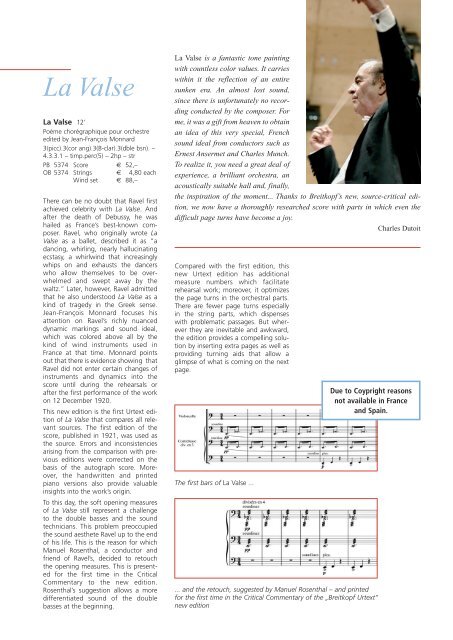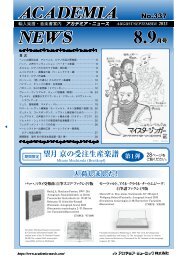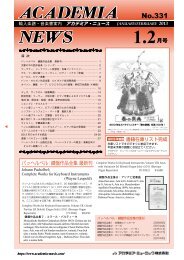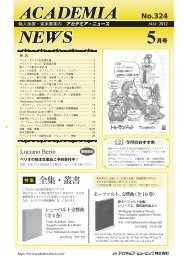Create successful ePaper yourself
Turn your PDF publications into a flip-book with our unique Google optimized e-Paper software.
La ValseLa Valse 12’Poème chorégraphique pour orchestreedited by Jean-François Monnard3(picc).3(cor ang).3(B-clar).3(dble bsn). –4.3.3.1 – timp.perc(5) – 2hp – strPB 5374 Score € 52,–OB 5374 Strings € 4,80 eachWind set € 88,–There can be no doubt that Ravel firstachieved celebrity with La Valse. Andafter the death of Debussy, he washailed as France’s best-known composer.Ravel, who originally wrote LaValse as a ballet, described it as “adancing, whirling, nearly hallucinatingecstasy, a whirlwind that increasinglywhips on and exhausts the dancerswho allow themselves to be overwhelmedand swept away by thewaltz.” Later, however, Ravel admittedthat he also understood La Valse as akind of tragedy in the Greek sense.Jean-François Monnard focuses hisattention on Ravel’s richly nuanceddynamic markings and sound ideal,which was colored above all by thekind of wind instruments used inFrance at that time. Monnard pointsout that there is evidence showing thatRavel did not enter certain changes ofinstruments and dynamics into thescore until during the rehearsals orafter the first performance of the workon 12 December 1920.This new edition is the first Urtext editionof La Valse that compares all relevantsources. The first edition of thescore, published in 1921, was used asthe source. Errors and inconsistenciesarising from the comparison with previouseditions were corrected on thebasis of the autograph score. Moreover,the handwritten and printedpiano versions also provide valuableinsights into the work’s origin.To this day, the soft opening measuresof La Valse still represent a challengeto the double basses and the soundtechnicians. This problem preoccupiedthe sound aesthete Ravel up to the endof his life. This is the reason for whichManuel Rosenthal, a conductor andfriend of Ravel’s, decided to retouchthe opening measures. This is presentedfor the first time in the CriticalCommentary to the new edition.Rosenthal’s suggestion allows a moredifferentiated sound of the doublebasses at the beginning.La Valse is a fantastic tone paintingwith countless color values. It carrieswithin it the reflection of an entiresunken era. An almost lost sound,since there is unfortunately no recordingconducted by the composer. Forme, it was a gift from heaven to obtainan idea of this very special, Frenchsound ideal from conductors such asErnest Ansermet and Charles Munch.To realize it, you need a great deal ofexperience, a brilliant orchestra, anacoustically suitable hall and, finally,the inspiration of the moment... Thanks to Breitkopf’s new, source-critical edition,we now have a thoroughly researched score with parts in which even thedifficult page turns have become a joy.Charles DutoitCompared with the first edition, thisnew Urtext edition has additionalmeasure numbers which facilitaterehearsal work; moreover, it optimizesthe page turns in the orchestral parts.There are fewer page turns especiallyin the string parts, which dispenseswith problematic passages. But whereverthey are inevitable and awkward,the edition provides a compelling solutionby inserting extra pages as well asproviding turning aids that allow aglimpse of what is coming on the nextpage.The first bars of La Valse ...Due to Coypright reasonsnot available in Franceand Spain.... and the retouch, suggested by Manuel Rosenthal – and printedfor the first time in the Critical Commentary of the „Breitkopf Urtext“new edition







